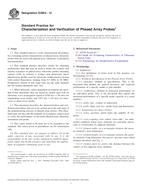Potrebujeme váš súhlas na využitie jednotlivých dát, aby sa vám okrem iného mohli ukazovať informácie týkajúce sa vašich záujmov. Súhlas udelíte kliknutím na tlačidlo „OK“.
ASTM E1411-09
Standard Practice for Qualification of Radioscopic Systems
Automaticky preložený názov:
Štandardná prax pre Kvalifikácia radioskopickou systémov
NORMA vydaná dňa 1.7.2009
Informácie o norme:
Označenie normy: ASTM E1411-09
Poznámka: NEPLATNÁ
Dátum vydania normy: 1.7.2009
Kód tovaru: NS-41667
Počet strán: 12
Približná hmotnosť: 36 g (0.08 libier)
Krajina: Americká technická norma
Kategória: Technické normy ASTM
Kategórie - podobné normy:
Anotácia textu normy ASTM E1411-09 :
Keywords:
contrast sensitivity, duplex wire gage, edge sharpening, focal detector distance (FDD), focal object distance (FOD), focal spot size, image processor, image quality indicator, imager, line-pair gage, magnification, near real-time radioscopy, noise reduction, penetrating radiation, radioscopic, radioscopic examination geometry, raster scan, real-time radioscopy, spatial resolution, static mode, step wedge, transmitted beam, Performance--laboratory instrumentation/process, Radioscopic examination
Doplňujúce informácie
| Significance and Use | ||||||||||||||||||||||||||
|
As with conventional radiography, radioscopic examination is broadly applicable to the many materials and object configurations which may be penetrated with X-rays or gamma rays. The high degree of variation in architecture and performance among radioscopic systems due to component selection, physical arrangement and object variables, makes it necessary to establish the level of performance which the selected radioscopic system is capable of achieving in specific applications. The manufacturer of the radioscopic system, as well as the user, require a common basis for determining the performance level of the radioscopic system. This practice does not purport to provide a method to measure the performance of individual radioscopic system components which are manufactured according to a variety of industry standards. This practice covers measurement of the combined performance of the radioscopic system elements when operated together as a functional radioscopic system. This practice addresses the performance of radioscopic systems in the static mode only. Radioscopy can also be a dynamic, real-time or near real-time examination technique which can allow test-part motion as well as parameter changes during the radioscopic examination process. The use of this practice is not intended to be limiting concerning the use of the dynamic properties of radioscopy. Users of radioscopy are cautioned that the dynamic aspects of radioscopy can have beneficial as well as detrimental effects upon system performance and must be evaluated on a case-by-case basis. This qualification procedure is intended to benchmark radioscopic system performance under selected operating conditions to provide a measure of system performance. Qualification shall not restrict operation of the radioscopic system at other radioscopic examination parameter settings which may provide improved performance on actual examination objects. Radioscopic system performance measured pursuant to this practice does not guarantee the level of performance which may be realized in actual operation. The effects of object-geometry and orientation-generated scattered radiation cannot be reliably predicted by a standardized examination. All radioscopic systems age and degrade in performance as a function of time. Maintenance and operator adjustments, if not correctly made, can adversely affect the performance of radioscopic systems. The performance of the radioscopic system operator in manual and semi-automatic radioscopic systems is not taken into account in this practice and can have a major effect upon radioscopic system performance. Operator qualifications are an important aspect of system operation and should be covered in a separate written procedure. |
||||||||||||||||||||||||||
| 1. Scope | ||||||||||||||||||||||||||
|
1.1 This practice provides test and measurement details for measuring the performance of X-ray and Gamma ray radioscopic systems. Radioscopic examination applications are diverse. Therefore, system configurations are also diverse and constantly changing as the technology advances. 1.2 This practice is intended as a means of initially qualifying and re-qualifying a radioscopic system for a specified application by determining its performance level when operated in a static mode. System architecture including the means of radioscopic examination record archiving and the method for making the accept/reject decision are also unique system features and their effect upon system performance must be evaluated. 1.3 The general principles, as stated in this practice, apply broadly to transmitted-beam penetrating radiation radioscopy systems. Other radioscopic systems, such as those employing neutrons and Compton back-scattered X-ray imaging techniques, are not covered as they may involve equipment and application details unique to such systems. 1.4 Units—The values stated in SI units are to be regarded as standard. No other units of measurement are included in this standard. 1.5 This standard does not purport to address all of the safety concerns, if any, associated with its use. It is the responsibility of the user of this standard to establish appropriate safety and health practices and determine the applicability of regulatory limitations prior to use. For information on safety requirements, refer to the applicable documents listed in Section 2. |
||||||||||||||||||||||||||
| 2. Referenced Documents | ||||||||||||||||||||||||||
|
Podobné normy:
Historická
1.12.2011
Historická
15.1.2012
Historická
1.6.2013
Historická
1.6.2013
Historická
1.11.2012
Historická
1.7.2013



 ASTM E2861-11
ASTM E2861-11 ASTM E2862-12
ASTM E2862-12 ASTM E2884-13e1
ASTM E2884-13e1 ASTM E2903-13
ASTM E2903-13 ASTM E2904-12
ASTM E2904-12 ASTM E2934-13
ASTM E2934-13
 Cookies
Cookies
